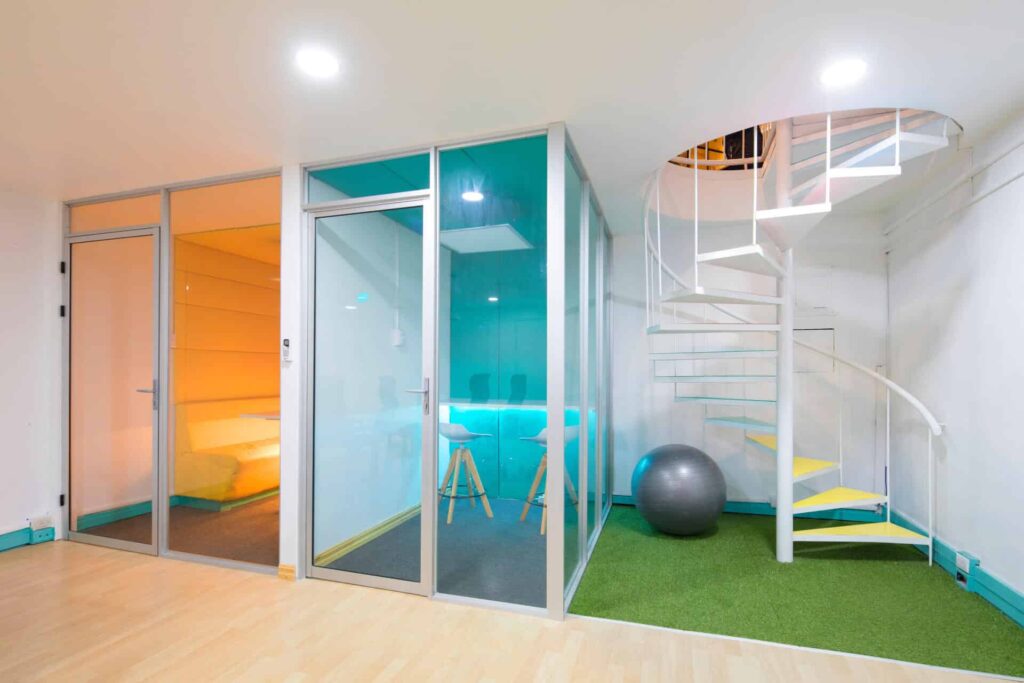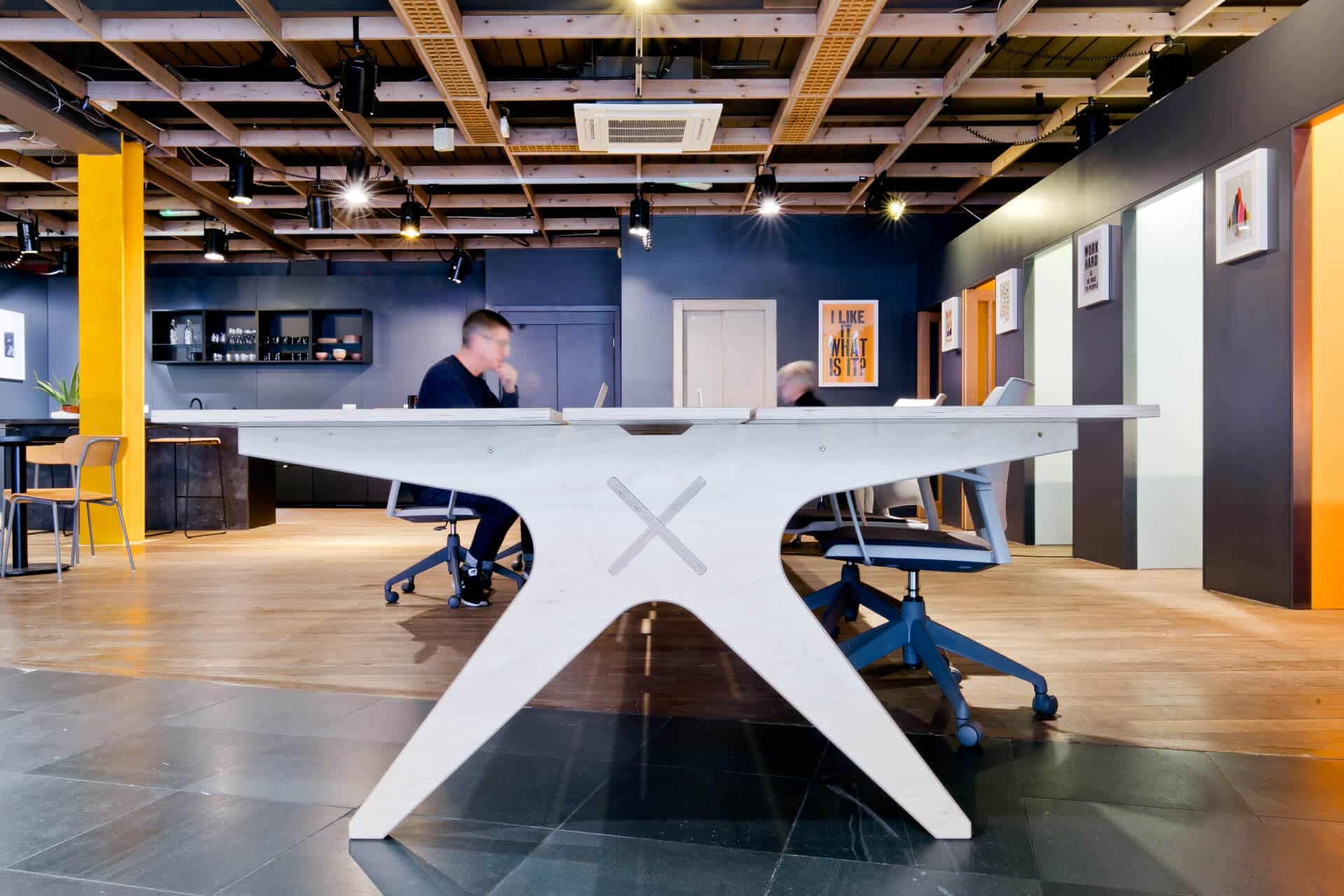Hybrid work model pros and cons will be on the minds of many organizations as we move into a post-pandemic world. Some workplaces may have been dipping their toes into hybrid models before 2020. But the pandemic thrust everyone into new ways of working, sometimes literally overnight.
Employees and employers have overwhelmingly enjoyed many hybrid workplace benefits. But hybrid work also presents many immediate and long-term challenges. This may leave many wondering if this hybrid work model is ‘worth it.’
A year and a half since the pandemic began, companies now have the breathing room to create more thoughtful, likely hybrid workplaces that are a better design for both employees and the bottom line. To do that, they’ll have to first consider all major hybrid workplace model pros and cons. Let’s explore.

Hybrid work model pros
The hybrid workplace is one that uses any combination of in-office and remote work. There’s no doubt it will be front and center in the future of work. Countless organizations have embraced different hybrid work models to suit their needs, but is hybrid really worth it?
The pandemic certainly accelerated existing trends, like adopting integrated workplace management software (IWMS), smart sensor technology and flexible working.
And of course, it ushered in hybrid work, in what academic Eric Brynjolfsson calls one of the biggest workplace transformations since World War II.
Like everything, this pivot was not without its problems, thanks to the advantages and disadvantages of the hybrid model. But overall, the reception to most hybrid workplace trends has been overwhelmingly positive. In fact, a Prudential study found that 87% of workers would prefer to work remotely at least one day a week. And 33% don’t want to work for an employer that requires them to be on-site full time.
It’s why Google, for example, is moving to a work schedule where most employees work in-office three days a week, and remotely for the other two. This follows the now popular nomad hybrid work model.
These positive responses are due to the many advantages of the hybrid work model. Hybrid work model pros include:
Increased productivity
One of the key takeaways from the pandemic has been that sitting at an assigned desk is not inherently more productive than working at your kitchen table or local coffee shop. That’s why one of the biggest pros of hybrid workplace models is their increased productivity.
For example, a Stanford study finds that workers are 13% more productive at home. This is due in large part to a reduction in breaks, time off and sick days.
Another study of over 12,000 employees finds that 75% of those who transitioned to home work due to the pandemic were at least as productive as at the office.
And according to Fortune, working from home will lift productivity in the entire U.S. economy by 5%. This is primarily thanks to savings in commuting time.
Ultimately, when employees work remotely, the focus shifts from time worked to task accomplished. It’s not the hours on a time clock that matter. It’s the quality and timeliness of the work itself—with a more positive and productive work environment being the result. When employees have the power and autonomy to make choices about when and where they work, they often work smarter and more efficiently.
Increased flexibility and agility
While many employees prefer a hybrid model, nearly all are also clamoring for more flexibility at work.
Hybrid working is by definition flexible, and it also dovetails with other responsive workplace models. Activity-based work, agile work, and office neighborhoods all integrate easily into a hybrid workplace environment. These ways of working are all designed to empower employees. Employees should have more control over how, when and/or where they work.
This increased flexibility helps hybrid office spaces better attract new employees and keep existing employees happy and engaged.

Better use of space
Hybrid workplaces offer efficiency in many areas, including in use of space. When they don’t need rows and rows of cubicles and conference rooms, suddenly offices can think about more creative and productive uses of their real estate.
For example, hybrid workplaces can more easily adopt activity-based workspaces. This type of workspace lets the type of work being performed dedicate the use of space. This means that offices can create quiet, collaborative or creative spaces and meeting rooms as best suits their team.
Activity based workspace design is undoubtedly the future of work, embraced by companies like Microsoft, Pixar, LinkedIn and Uber. By offering fresh and attractive workspaces, it’s another tool to help recruit new hires and promote a compelling company culture. And as we’ve mentioned, it perfectly complements a hybrid office.
And like the name suggests, office neighborhoods group workers into areas dedicated to specific departments or functions. Especially when coupled with hybrid work, they can increase productivity and collaboration, thus making much better use of office space.
Finally, better space planning in a hybrid office means that companies can forecast, manage, and track how their workspace is being used. This allows them to better adapt to meet their needs going forward.
Increased cost savings
Fewer people working in a hybrid work environment means offices can usually save on real estate and associated costs. This is as long as facility managers (FMs) plan the space more effectively.
For example, AT&T cut its annual real estate costs by $30 million when it first implemented virtual office work for some team members in the early 2000s. Meanwhile, IBM has cut real estate costs by $50 million, Sun Microsystems saves $68 million a year, and Dow Chemical and Nortel save 30% on non-real estate costs.
And while full-time remote work can save companies an average of $10,000 per employee per year, employers can reap many of these same cost savings with a hybrid model. A hybrid model uses space and move management planning and software.
For example, office hoteling software is a user-friendly reservation system for the office. It allows team members to reserve space on any given workday, and FMs to track how they do so. This type of dynamic workplace management software helps FMs ensure the workspace is set up with maximum efficiency. This often includes offering big savings on real estate in the process.

Increased access to potential employees
Another major hybrid model advantage is that it offers companies a much larger talent pool when hiring new employees. Companies that are willing to allow for hybrid and remote work are essentially leveling the playing field when it comes to geography. They can now recruit from a nationwide or even worldwide pool of talent, instead of being limited by small, geographic constraints.
It’s why Mark Zuckerberg has welcomed opening up to new pools of talent, and given the increasing competition for talent which we’ll cover below, it can make hiring much easier and more fruitful.
Improved employee experience
Employee experience is essentially the overall well-being of staff. It is usually enhanced by more flexible and hybrid work options.
By putting more decision-making power into the hands of employees, hybrid work provides a higher level of autonomy and job satisfaction. This can lead to both a better workflow and a better work-life balance. Many employees have also welcomed hybrid because it lets them avoid the burnout of long commutes and the monotony of sameness, further improving the employee experience.
And employee experience matters, thanks to what Forbes calls a “stealth war for talent in this new post-pandemic return-to-work environment.” The economy is ramping up, and with the sudden need for employment, job seekers have the upper hand—and they need to be courted.
Even before the pandemic hit, Gallup research found that 54% of office workers said they’d leave their job for one that offers more flexibility.
And today, more employees are quitting now than at any other time in the past two decades.
With this new glut of choice available to employees, companies can use their hybrid workplace as an asset for recruitment and retention. Letting employees work when and where they’re happiest and most productive is fundamentally a smart policy for building and sustaining top-notch work teams.
Improved health and safety
As we’ve learned, employees are looking forward to returning to the office in a flexible capacity, as long as it is safe to do so. That means companies may need to go above and beyond mandated health regulations, which themselves can be difficult to manage.
One major hybrid workplace model benefit is that it promotes the health of employees by allowing them to work where they’re most comfortable. For example, if an employee is feeling a bit under the weather but well enough to work, they can choose to work remotely. Hybrid working also makes it much easier to navigate precautionary quarantining.
This flexibility offered by hybrid working will help keep all employees safer. At the same time, it furthers a sense of well-being in the workspace.
And of course, it’s much easier to maintain social distancing in a hybrid work environment. That said, having any number of employees in a shared space inherently presents health and safety concerns. This is why the hybrid workplace has prompted many FMs to implement extra safety features.
For example, Safeguard gives companies the ability to easily implement customizable COVID-19 wellness checks, critical in coworking environments. And Distancing Planner is easy-to-use software that creates instant distanced seating plans, simplifying social distancing in the workplace. Finally, desk booking software that keeps track of when desks are being used means cleaning staff can know exactly when and what to clean, further ensuring employee safety.

Hybrid work model cons
Clearly, these numerous hybrid work models benefits are very enticing for many organizations. But any workplace looking to implement or solidify a hybrid work model needs to be aware of potential drawbacks, too.
Namely, there are several disadvantages of the hybrid model that FMs and companies should consider before committing to it. Let’s take a look at some hybrid work model cons:
Communication issues
Communicating in traditional offices was a given. It happened naturally and spontaneously, whether that was in planned, easy-to-organize meetings, in hallways, over cubicle walls or at the fabled water cooler.
But authentic communication in real time is generally more difficult when employees aren’t sharing a physical space.
Moreover, the more organizations tap into wider employee talent pools, the more likely they are to hire people from different time zones. This can further complicate communication.
That’s why miscommunication and missed communications between asynchronous hybrid teams is one of the biggest challenges FMs will have to overcome going forward. They’ll therefore have to use the best hybrid working tools to foster meaningful connections among hybrid teams.
Integrating tools like Microsoft Teams and Slack can make it easier for all team members to stay in touch in real-time.
And Zoom meetings are clearly here to stay. That said, managing hybrid meetings is challenging, we know that Zoom fatigue is real. As such, employers should be judicious with their use of meetings. They should also ensure one-on-one check-ins with team members happen regularly.

Divisions between employees
Another disadvantage of the hybrid model is that it can introduce divisions between employees, especially between in-office and remote workers.
Sometimes, this can be a simple problem with a simple solution.
For example, OfficeSpace client Rapid7 addressed a feeling of disconnect among their hybrid team by introducing technology that allowed people dialing remotely into meetings to have more of a physical presence.
But certain divisions between employees can run deeper in a hybrid work environment if they are not managed correctly. If full-time remote employees don’t have the home office environment or supplies needed to do their job, they may feel disadvantaged. They may also feel judged or alienated, or like they’re missing out on even simple perks like office parties or after-work drinks.
Meanwhile, employees working entirely in-office may resent fellow employees who have more perceived flexibility.
Many of these challenges can be overcome by implementing agile working. This is where all employees are able to direct when and how they work, no matter where they’re working. This can certainly lead to less resentment among teams, since everyone is better able to have their individual needs met.
It’s also important to note that remote work can exacerbate diversity and inclusion problems. It can also lead to more people feeling or in fact being more marginalized. Hybrid work can also exacerbate existing tensions between different generations in the workplace. For example, survey data shows that most Gen Z employees find hybrid work most appealing, while Millennials and Gen X prefer working from home full-time.
That said, all generations in the office tend to appreciate increased flexibility, making it easier to manage these tensions. Certainly, most issues around division between employees can be overcome by empowering and supporting employees.
Employee experience struggles
The productivity that makes working from home so appealing can be a double-edged sword. Not all employees thrive in this set-up.
20% of remote workers report struggling with loneliness. And 18% report being unable to unplug from work. This highlights that this type of work can lead to more negative issues for some workers.
So the impact on employee experience can be either an advantage or disadvantage of the hybrid model. That’s why the onus is on management and FMs to implement the right hybrid model for their team.
Difficulty implementing
As these disadvantages of hybrid work models illustrate, this is a complex model that must be implemented correctly to ensure success. Increased reliance on technology can definitely be tricky without an efficient facilities management team to support remote work.
Maintaining cyber security for remote workers can also be a challenge. And increasing charging stations and wifi use in a building poses an increase in threats to building automation systems.
Hybrid will therefore only work well when a company or FM team have the tools, processes, and management skills necessary to provide an increase of freedom and autonomy to workers.
The technology is available to drastically improve workflows and productivity, as long as FMs implement it correctly.
Like Brynjolfsson says, “we have an opportunity to measure things a lot better—there’s a lot more real-time data and information. Most companies are flying blind when they could be using a lot more digital data to know where they’re going, what the opportunities are, what skills are in their workforce, [and] what skills are needed.”
It’s why hybrid working software is critical to ensure companies can implement hybrid work in the right way.
And it’s why employee buy-in is also critical. Forward-thinking companies don’t just want to avoid pushback on their work model—they want employees to embrace it wholeheartedly. As such, they’ll need to implement the right technologies in the right way, coupled with clear communication to their teams.

Hybrid work is only beneficial when it’s done right
Hybrid work model pros and cons aren’t necessarily black and white. How well the hybrid work model works really comes down to how well it’s implemented and what tools are used to do so. Proper hybrid working tools are critical, but so is a company culture that trusts employees and prioritizes their well-being.
There’s a reason so many companies are embracing hybrid working. All-remote working and all-in-office working both have many drawbacks that many companies simply won’t be able to overcome. But FMs can manage the pros and cons of the hybrid work model to balance them in a way that benefits both employees and employers.
As such, companies will have to make their own assessment of hybrid work model pros and cons, to see if it will benefit their organization.
OfficeSpace helps organizations of all sizes implement the best hybrid software for their teams. Reach out for a free demo.
Photos: Ewan Buck, Slidebean, CoWomen, cottonbro, RODNAE Productions, Product School, Leon




